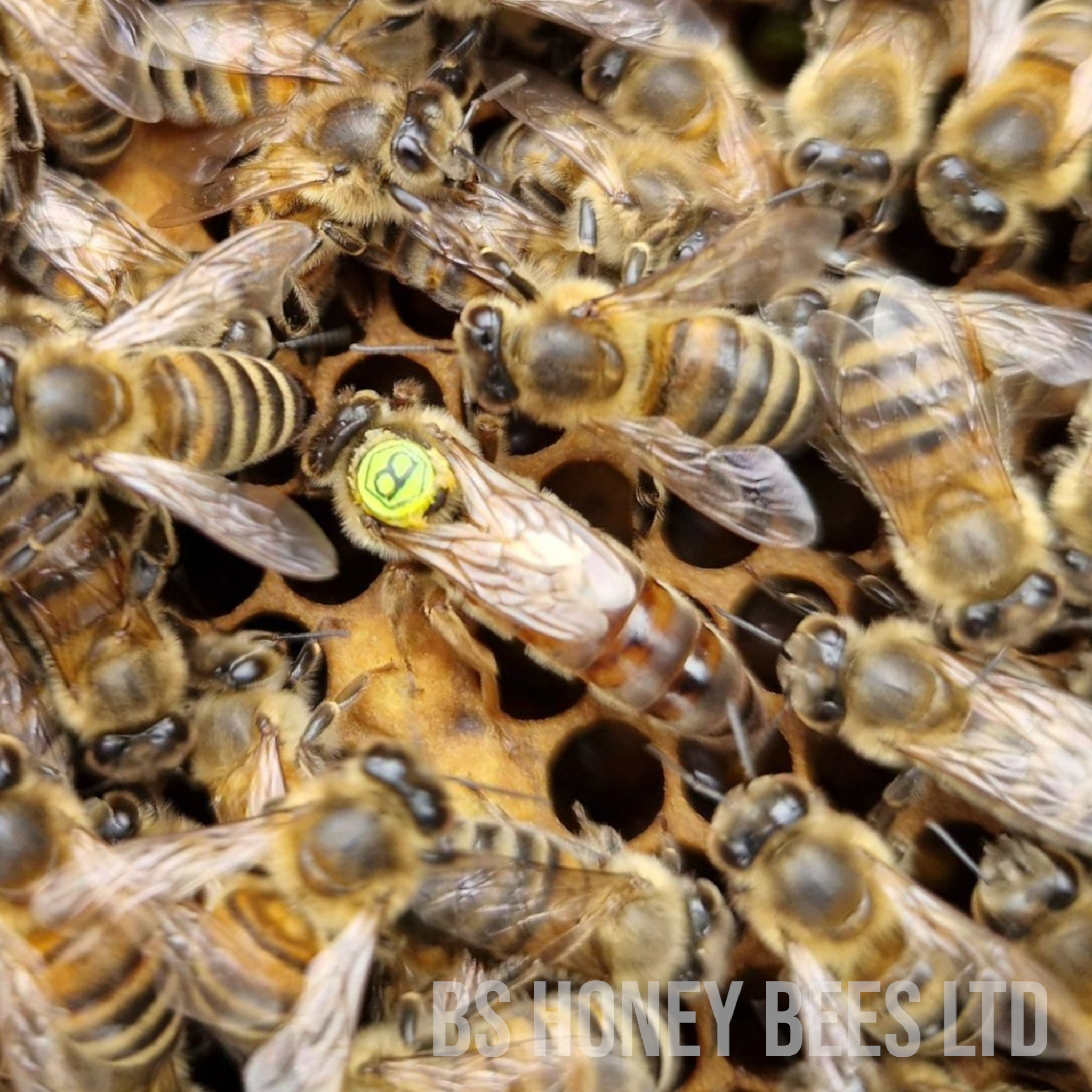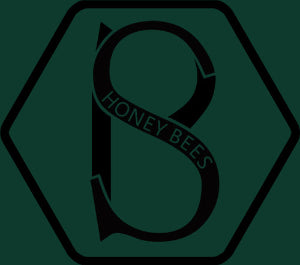How to introduce a Queen Bee
We recommend for the successful introduction of a new queen, that she is inserted during suitable conditions. E.g. ideally the bees are on a good honey flow, it is not raining and there are many older bees foraging. Ideally, we always recommend ensuring the Hive is not broodless as lack of brood may increase the chances of the colony developing the laying worker pheromone, which makes it very hard to introduce a Queen successfully. We also recommend always keeping her out of any direct sunlight. Our Queens are marked to the year accordingly and generally contain 4-6 attendant (worker) bees to help feed and groom her during her time in transit. Whilst we make every effort to ensure the Queens leave us marked, in exceedingly rare occasions these marks are then cleaned off by the attendant bees in transit or once introduced to the hive. This is something beyond our control thus we cannot be held responsible should this happen. All our queens are supplied unclipped.
We use the following cages within our operation which will always contain some form of candy (fondant) that will be sealed at one end. This is normally in the form of a clip (or clips) or some tape, this can be removed prior to introduction or be used as an option to delay the release for an extra day or two. When we pack the Queens, the candy is soft, but we always recommend you check the candy has not hardened in transit (this will depend on the time of year and weather). If you are concerned the candy is too hard you can use a cocktail stick to poke a small passageway in the candy to help the bees start eating.

General Introduction
The general introduction process is fairly simple, your Queen can be introduced in the cage provided with the attendant bees, ideally tucked snug between 2 frames (sideways) where the bees are most active. You can either opt to remove the candy clip(s) / tape immediately or choose to delay this by 24-48 hours to help the colony adjust to her new pheromones. If you believe the cage to be unstable and likely to drop down, use a cocktail stick or matchstick to keep the cage suspended between the frames (in this situation we recommend, candy face down). Do not remove her from the cage, there is candy inside the cage which the bees will eat through and slowly release her over a period of 2-3 days. After the initial introduction wait 7 days before returning to check for acceptance in the form of either seeing the Queen or the presence of eggs in the cells (like very small individual grains of rice). We cannot stress how important it is you avoid checking the hive during those 7 days, any earlier can result in accepted Queens being “balled” (killed) prematurely.
Queen Introduction Timeframe
Ideally the colony must have been Queenless for at least 24 hours by means of finding and removing of the original Queen or confirmed with a test frame.
Test Frames / Confirming Queen State
Before introducing any mated Queen to a colony that you suspect is possibly Queenless, we always recommend a thorough check to establish there are no Queen cells or unmated (virgin) Queens within the hive. As virgin Queens can be very nimble and fast this can sometimes be hard for the inexperienced (and even experienced!) beekeepers to find. If this is a Nuc that you have made by isolating the Queen when creating the Nuc this should not be something you will have to worry about. If you are still uncertain, we recommend introducing a “test frame”, this is a frame with eggs / young larvae that bees can use to produce “Emergency Queen Cells”, this frame will need to come from another colony, with all the bees removed from the test frame before introducing it to the Queenless colony(which is why it is always a good idea to have more than 1 hive). We recommend marking the frame, so it is easy to identify later. Normally it is then best to return after 2-4 days to confirm if the bees have started drawing Queen cells, if they have, this will confirm the hive is Queenless and it is best to destroy these Queen cells. If they have not made any Queen cells you either potentially have a virgin queen or a laying worker. A virgin queen will need to be found and removed prior to introduction. A laying worker colony is likely beyond recovery and is sometimes best shaken out or combined with another hive (using a newspaper method).
Re-Queening Aggressive Colonies
Queening aggressive colonies can certainly be a challenge, sometimes it can be near impossible to do successfully, so the risk would need to be considered when attempting this. Normally it would be best to identify any aggressive colonies during the season and re-queen when the population is low in the Spring (although Autumn would have a lower population, if something goes wrong at this time of year it is hard to rectify). Generally removing the original Queen and introducing a new Queen 24 hours later will not always be successful when the colony is strong, we recommend the following methods for aggressive colonies –
1. Creating a Nuc from the aggressive colony by temporarily isolating the existing Queen and removing 2 frames of sealed brood and a frame of pollen/honey (with bees) and an additional shake or two of bees. This can be either placed 3ft or 3 miles away from the parent colony. You can then introduce your new Queen to the Nuc 24 hours later as to our general introduction guidelines earlier in the page. Only once this Queen has been accepted, began laying and the Nuc is established (ideally 5/6 frames coverage with bees, brood & food) we can consider removing the aggressive Queen and uniting your Nuc with the original parent colony. From customer feedback and experience we have discovered this to be one of the most successful methods of re-queening aggressive colonies.
2. Bleeding off the foraging, older “grumpy” bees is an option when attempting to re-queen. This can be done by moving the parent colony 3ft or more away from the original location and placing a temporary Hive or Nuc box (with frames) in which the flying bees will return to. Ideally after 24hrs of good flying weather you should be left with young bees & brood within the parent colony, you can then remove your original Queen and introduce your newly mated Queen 24hrs later as to our general introduction guidelines earlier in the page.
Creating Nucs for Swarm Control or Expansion
We recommend to ideally find and temporarily isolate the existing Queen before identifying 2 sealed brood frames and 1 frame of stores (with bees) to transfer into a Nuc box. You can also opt to bolster the colony up by shaking more bees from 1 or 2 frames into the box. The Nuc needs to then be moved either 3ft or 3 miles away and left 24 hours before introducing your Queen as to our general introduction guidelines earlier in the page.
Top Tips
• Removing attendant bees – Whilst this was a practise we followed for over a decade, we found that time constraints meant we just did not have the resources to de-escort cages and began introducing them with the attendants with no adverse effects. If you opt to remove the attendant bees, we recommend doing this in a closed room (sometimes a vehicle) and within a clear plastic bag (recommend wax bags). Some variants of cages front cover will slide off, other variants will require the cap unclipping and the candy tube folding over. We have had many customers attempt this at their apiary and the Queen has quickly flown away, please do not do this. Generally, the attendants will make a quick exit from the cage allowing you to then isolate the Queen alone within the cage. The attendant bees can be shaken out from the bag within the apiary near to a hive they can fly into. We do not recommend this to inexperienced beekeepers and is completed at your own risk.
• Light sugar solution – This is a practise we have found beneficial in the past but not readily used in our daily bee keeping activities, it consists of using a clean garden sprayer to lightly spray the Queen cage with a thin sugar water solution. This can help with introduction as the bees clean the Queen and are able to gain the new scent and pass it around the colony.
• Push in cages – Whilst we have good acceptance in standard introduction cages, some push in cages (available from most beekeeping suppliers) allow the Queen to be isolated on an emerging brood frame with young bees as they hatch. She will hopefully replenish these hatched cells with fresh eggs and can be removed at your leisure (depending on the type of push in cage).
• Cheap masking tape – If you are as busy as us you may find you want to delay the bees getting to the candy but may not have the time to return to remove the clip/tape. The easiest method is to remove the clip and instead use a piece of cheap masking tape to cover the candy temporarily, with a small pin hole to give the bees somewhere to begin chewing. We have found this successful on most occasions but sometimes smaller hives/nucs were very reluctant/slow to begin so we recommend this option at your own risk.
• Liquid feeding – Sometimes feeding will help draw the Bees attention elsewhere, ideally enough to keep them occupied, but not too much so as to clog the brood frames with stores, thus not allowing any space for your new Queen to commence laying.
• My Queen has arrived dead, what do I do? - Please take a picture as soon as possible and send an email via our contact form for a replacement free of charge. Any Queens dead on arrival are replaced once and once only. Evidence must be supplied for this otherwise we cannot offer a replacement.
• My Queen has not accepted despite following your instructions, what do I do? - Unfortunately, when dealing with nature there are too many variables which can result in Queens not being accepted. As bee farmers this is something we see on a regular basis, and whilst frustrating, it is impossible to guarantee acceptance.
• Do you provide any discounts should my Queen not be accepted? - Unfortunately, this is something we cannot offer due to the reasons above.
• My Queen appears to be slow on arrival, what should I do? - Sometimes in Autumn or early Spring, Queens can become quite cool in the mailing system but will quickly begin to perk up with a bit of warmth. If she does not begin moving normally after warming please notify us as soon as possible.
• My Queen has arrived, but the weather is poor, can I keep her in her cage? - Generally, Queens can be kept caged for about 5 days in cool dark conditions watered 2 times a day using a garden misting spray or a couple of light drips under a tap. Keeping Queens caged for prolonged periods is not recommended and we cannot be held responsible for Queens that arrive alive and perish as a result of being stored for additional periods. Please try to plan for any unexpected circumstances, Queens are stored at your own risk.
• My Queen has not started laying after 7 days, what do I do? - Please let us know if this is the case via email. We do find, in some conditions, Queens may take a little longer to lay and would always recommend allowing at least 14 days.
• My Queen is only laying drones, what do I do? - Please take a picture as soon as possible and send an email via our contact form for a replacement free of charge. Any Queens are replaced once and once only. Evidence must be supplied for this otherwise we cannot offer a replacement.
• Do you provide any guarantees of your Queens performance or temperament? - Whilst all our Queens have a proven track record of producing very placid and productive bees, we offer no guarantee this will be the case. As with open mated Queens there are too many variables in nature that can lead to a Queen underperforming. Whilst Queens generally will last up to 2-3 years there is no guarantee.
We cannot give any guarantee that your new Queen(s) will be accepted but have provided this leaflet with the intentions that it will help. If you have any concerns about the health or egg laying of your new Queen(s) you must contact us within 14 days for a replacement. More information can be found on our online FAQ section, for any other issues or enquiries contact us: via our contact form or 01452 645635. For more information on queen introduction and videos visit youtube.com/bshoneybees




